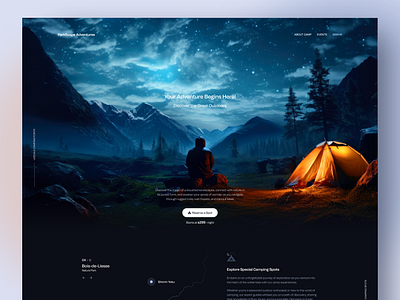Imaginative Web Style Solutions for Modern and Engaging Websites
In the world of internet style, the quest of modern and engaging solutions has actually come to be significantly crucial for services aiming to capture user focus. By incorporating strong color systems, interactive components, and receptive layouts, designers can develop experiences that not just resonate with customers yet likewise enhance brand name identification.
Accepting Bold Shade Plans
In website design, the calculated use of bold shade schemes can significantly boost individual engagement and brand name identity. By employing vivid colors, designers can develop visually striking websites that record attention and cultivate an unforgettable experience. A well-chosen shade palette not just reflects a firm's values yet likewise stimulates particular feelings that can influence customer habits.
Vibrant colors can be utilized to guide individuals' attention to crucial elements such as telephone calls to action, improving conversion rates. As an example, making use of contrasting colors for switches and links can make these aspects stand out, triggering customers to communicate even more easily. A natural color scheme across the web site enhances brand recognition, producing a sense of experience and trust fund amongst visitors.
However, it is vital to stabilize vibrant shades with adequate white space to avoid overwhelming individuals. Efficient use typography additionally enhances vibrant shades, ensuring readability while maintaining visual appeal. Ultimately, embracing bold color schemes in website design not only elevates aesthetic quality but also plays an integral role in achieving strategic business purposes, making it an essential factor to consider for modern-day internet growth.

Using Interactive Elements
Interactive aspects are important in modern-day web layout, as they considerably boost individual involvement and create a much more dynamic searching experience. By including features such as computer animations, float effects, and clickable components, websites can motivate customers to explore material better and return for future brows through.

Micro-interactions, such as refined computer animations when a button is clicked or a form is submitted, can also enhance the customer experience by supplying instant feedback. These tiny information can make the site really feel even more responsive and active, cultivating a sense of link in between users and the website.
Additionally, gamification components, such as benefits for finishing particular activities, can motivate individuals to involve with the material extra deeply. By thoughtfully incorporating these interactive parts, web developers can develop an unforgettable and interesting online experience that resonates with customers and encourages them to return.
Carrying Out Receptive Design
Carrying out receptive design is important in today's multi-device landscape, ensuring that sites supply an optimum viewing experience across different display sizes. As individuals significantly access the net via mobile phones, tablet computers, and desktops, a one-size-fits-all method is no longer viable. Receptive layout enables seamless navigation and interaction, adjusting format and web content to fit the tool being used.
Secret principles of responsive design consist of liquid grids, versatile pictures, and media queries. Media queries promote the application of various styles based on the device's characteristics, such as size, elevation, or resolution, enabling designers to customize the customer experience successfully.
Furthermore, responsive layout improves SEO performance, as internet search engine prefer mobile-friendly sites. By implementing receptive style, businesses not just enhance user contentment and interaction but additionally boost their reach in a competitive electronic landscape. As innovation Get More Information continues to progress, adopting receptive style has actually ended up being a fundamental technique for any modern-day and appealing internet site.
Incorporating Multimedia Content
Multimedia material plays a vital duty in creating interesting and dynamic internet experiences that capture individuals' focus and improve understanding. By incorporating text, photos, audio, and video clip, websites can use a richer story that charms to numerous learning designs and choices. This combination not just bolsters individual involvement but likewise help in conveying complicated concepts succinctly.
Incorporating high-quality images and infographics can damage up textual web content, making it more digestible. Video tutorials and presentations can supply comprehensive insights that static material may not completely connect. Audio components, such as podcasts or history music, can also improve the environment of a web site, developing an extra immersive experience.
Moreover, the click site tactical use of multimedia can enhance SEO performance, as online search engine prefer varied material types, boosting exposure. It is critical to make certain that multimedia components do not impede page tons times, as this can lead to user aggravation. By balancing multimedia integration with efficiency factors to consider, web designers can create aesthetically enticing and functional sites that resonate with customers, fostering a much deeper link and motivating return check outs.
Focusing On User Experience

To attain an optimal user experience, designers need to concentrate on numerous key principles. First, responsive style is crucial; websites should adapt perfectly to different gadgets and display dimensions. This ease of access guarantees that individuals can engage with content regardless of their chosen platform. Second of all, quality in format and power structure is critical. Clear telephone calls to activity, understandable typography, and organized content overview customers, minimizing cognitive tons.
Inevitably, prioritizing UX not only boosts user contentment but likewise drives involvement and conversion rates, making it an essential element of contemporary internet design methods. By positioning users at the facility of layout efforts, sites can develop lasting, positive perceptions that urge return gos to.
Verdict
In final thought, contemporary web design solutions that stress vibrant shade plans, interactive aspects, responsive design, and multimedia material considerably enhance user involvement and contentment. las vegas seo. Focusing on individual experience through clear formats and continual comments further contributes to enhanced conversion prices.